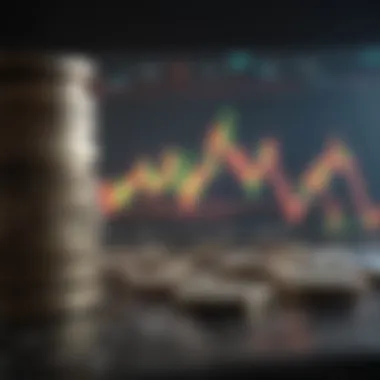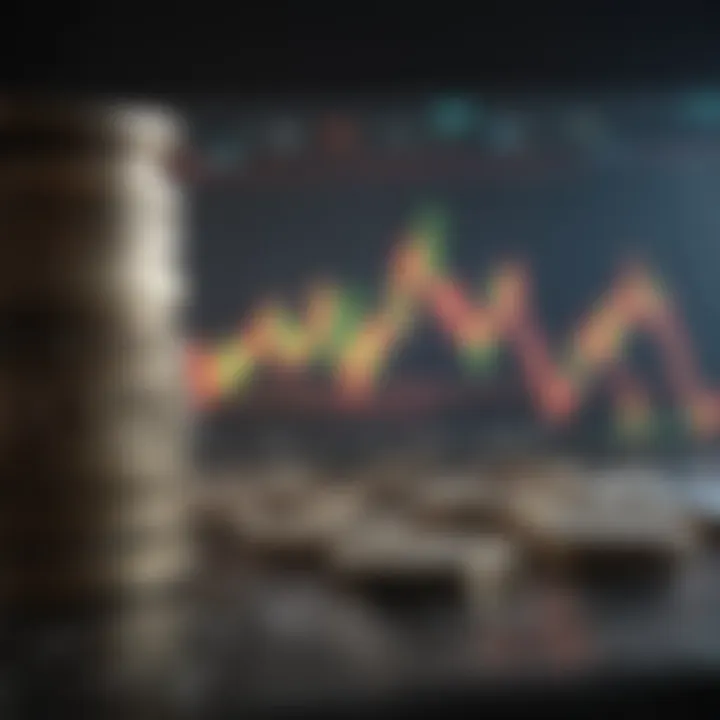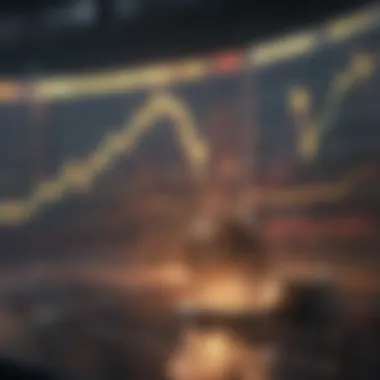Mastering Forex Trading: A Complete Guide


Intro
In the realm of investing, one cannot overlook the omnipresence and influence of foreign exchange, or Forex, trading. The allure of Forex lies in its potential for both profit and risk, shaping the financial landscape in unique ways. Understanding the core concepts of this market is essential for anyone looking to dive in.
More than just a game of buying and selling currencies, Forex trading is a dynamic dance influenced by a multitude of factors—from economic indicators to geopolitical events. This guide endeavors to equip both nascent and seasoned traders with the tools, terminology, and strategies needed to navigate this complex environment.
Let's embark on this journey by laying down the foundational terms.
Investment Terminology
Key Definitions
Engaging with Forex necessitates familiarity with certain terminologies that are the bread and butter of the trading world. Below are some pivotal definitions to help you kick off:
- Pips: The smallest price move that a given exchange rate can make based on market convention. In currency pairs, a pip typically refers to a movement in the fourth decimal place.
- Leverage: This refers to the ability to control a large position with a relatively small amount of capital, amplifying potential returns but also risks.
- Spread: The difference between the buying price (ask) and the selling price (bid) of a currency pair. A tighter spread often signifies higher liquidity.
- Margin: The amount of money that a trader must deposit to open a position. This reflects what is put up as collateral against leveraged trades.
Commonly Used Terms
A deeper understanding of the lingo can be beneficial when trading. Here are more terms to get aquainted with:
- Currency Pair: Currencies are traded in pairs, indicating how much of one currency is needed to purchase a unit of another. For instance, in EUR/USD, the Euro is the base currency.
- Bullish/Bearish Trends: Bull markets show rising prices, while bear markets indicate falling prices. Recognizing these trends can guide trading decisions.
- Liquidity: This term describes the ease with which an asset can be bought or sold in the market without affecting its price.
In foreign exchange trading, understanding terminology is not just beneficial—it's essential for making informed decisions.
Expert Advice
Investment Strategies
When it comes to trading strategies, a one-size-fits-all approach seldom works. Here are a couple of notable methods:
- Technical Analysis: This involves studying price movements and past market data to predict future price actions. Traders often use charts and indicators to decipher market trends.
- Fundamental Analysis: This strategy focuses on the economic factors that can influence currency values, such as interest rates, inflation, and political stability.
Risk Management Tips
Managing risk is just as crucial as formulating strategies:
- Use Stop-Loss Orders: These orders can help mitigate losses by automatically closing a trade at a set price.
- Diversify Your Portfolio: Spread your investments across different currencies and markets to minimize risk exposure.
Forex trading is undoubtedly a complex field, but understanding its fundamental components lays the groundwork for informed decision-making.
Understanding the Foreign Exchange Market
Understanding the Foreign Exchange (Forex) market is essential for anyone looking to delve into trading currencies. It acts as the gateway for individuals and institutions to buy and sell currencies all over the globe. Comprehending the intricate dynamics of this market opens up opportunities for savvy investors to capitalize on currency fluctuations, thereby enhancing their financial portfolios.
When we skim the surface of Forex trading, we see not just numbers bouncing around, but a living market influenced by various factors, including economic indicators, geopolitical events, and trading psychology. A solid grasp on these concepts aids traders in making well-informed decisions, which can significantly affect their success in this competitive landscape.
Moreover, having a deep understanding of the Forex market provides a framework to gauge the effectiveness of various trading strategies and risk management techniques, ultimately guiding traders toward achievable goals and sustained profitability.
Definition and Scope
The Foreign Exchange market, often abbreviated as Forex or FX, refers to the global marketplace where currencies are traded. Unlike stocks or commodities, Forex is decentralized and operates 24/5, meaning that from the opening bell in Sydney to the closing in New York, the market is continuously in motion. This bustling environment allows countless transactions to occur involving currencies of different nations, driven by the need for exchange due to trade, investment, and tourism.
The scope of Forex trading is monumental. In fact, it is the largest financial market in the world, with an estimated daily trading volume of over $6 trillion. This immense scale means that even a small trader can participate effectively and, if lucky, seize the right moment to make substantial profits.
Historical Background
The history of Forex trading is as rich as it is varied, dating back to ancient civilizations where currency exchange was done in a rudimentary form. Over centuries, as trade evolved, so did the methods of currency exchange. The gold standard system that emerged in the 19th century paved the way for fixed exchange rates linking currencies to gold, establishing a semblance of stability in global trade.
Post World War II, the Bretton Woods Agreement allowed currencies to float against the U.S. dollar until the system’s collapse in the 1970s, leading to the Forex market we recognize today—where currencies float against one another, governed by supply and demand dynamics rather than a fixed value.
Market Participants
The Forex market encompasses a variety of participants, each playing a pivotal role in maintaining its fluidity and vibrancy. Understanding who these key players are aids traders in perceiving market movements and strategies better.
Retail Traders
Retail traders, often the small fish in this vast ocean, comprise individual investors who speculate on currency movements through trading platforms. The main draw for retail traders is the accessibility of Forex trading; many brokers allow entry with minimal capital. This opens the doors for both novices and experienced individuals alike.
A distinguishing feature of retail traders is their reliance on technical analysis, using charts and indicators to forecast trends. While they may not possess the capital of institutional traders, their flexibility and varied strategies can yield decent profits.
Institutional Traders
Institutional traders operate on a grander scale, often representing banks, hedge funds, or any financial entity dealing with Forex transactions. These players have substantial resources and often trade in significant volumes, influencing the market's direction.
Their key characteristic is the ability to analyze macroeconomic factors and deploy sophisticated algorithms, giving them an edge over retail traders. However, the high stakes and vast competition mean that mistakes can be costly, illustrating the cut-throat nature of institutional trading.
Central Banks
Central banks play a critical role, acting as regulators of the currency systems by influencing their value through monetary policy, interest rates, and currency intervention. When a currency appears too strong or too weak, central banks may step in to stabilize its value, thus ensuring economic stability in their respective countries.
The unique feature of central banks in Forex trading is their power to instantly influence the market with policy changes. However, the information can be scarce and sometimes appears late, leaving traders to second-guess the central banks’ next move.
Brokerage Firms
Brokerage firms serve as the intermediaries for all forex traders, providing access to the market through trading platforms. The right broker can mean the difference between a successful trade and a missed opportunity. Different types of brokers—market makers, Electronic Communication Network (ECN) brokers, and Straight-Through Processing (STP) brokers—offer varying services, each with distinct advantages and disadvantages.
Brokers enable retail traders to execute trades, but not without cost. Understanding the fee structures and spreads offered by different brokerage firms is essential since they can eat into the profits.
"Knowing the market participants allows you to navigate and strategize your trades more effectively."
Understanding the Forex market and its participants thus equips traders with vital insights, facilitating informed decisions aimed at improving performance in trading. This foundational knowledge becomes integral, as without it, navigating the currency currents can feel like trying to sail a ship through a storm without a compass.
How Forex Trading Works
Understanding how Forex trading works is crucial for anyone looking to make sense of this expansive market. At its core, trading foreign currencies is less about success or failure in individual trades and more about grasping the intricate dance of currency values, market sentiments, and the forces that drive price movements. By developing insight into the mechanics of Forex trading, investors can navigate the complex environment with a greater degree of confidence.
Currency Pairs Explained
Currency pairs form the foundation of Forex trading. These pairs epitomize the relationship between two currencies, showcasing how much of one currency can be exchanged for another. In Forex, the currency pair is listed in two components: the base currency and the quote currency.
Major Pairs
Major pairs comprise the most frequently traded currencies in the market. They usually include the US dollar in combination with other major currencies like the Euro, Japanese Yen, and British Pound. A defining characteristic of major pairs is their liquidity, which suggests that traders can enter and exit positions without struggling to find a buyer or seller.
The tight spreads found in major pairs present another attractive feature, making them less costly to trade. Generally, traders favor these pairs because they can lead to quicker returns. Moreover, the high trading volume often means that news and economic data significantly impact their values.
Still, one should remember that the overwhelming focus on major pairs could lead to a missed opportunity in exploring diverse trading strategies.
Minor Pairs
Minor pairs, on the other hand, are those that do not include the US dollar. They usually consist of lesser-known currency combinations, such as the Euro and the British Pound. The beauty of minor pairs lies in their potential to offer volatility that major pairs may not present. While they may be less liquid, this could work in a trader’s favor. Often, lesser-known economic reports or geopolitical events can create shifts in price that can be advantageous.
That said, the lower liquidity may mean wider spreads, making trading more expensive during certain periods. This might require traders to be more selective and vigilant.
Exotic Pairs


Exotic pairs represent a combination of one major currency and one currency from a developing economy. Examples include USD/THB (Thai Baht) or EUR/TRY (Turkish Lira). These pairs can be enticing for traders looking for unique opportunities, as they tend to experience more pronounced price movements due to economic shifts in the exotic currency’s country.
However, using exotic pairs can come with notable challenges. For one, they frequently exhibit lower liquidity, meaning a trader might struggle to execute trades at desired prices during high volatility. Additionally, the spreads can be significantly wider, often leading to higher trading costs. So, while the potential for profit exists, the associated risks are likewise heightened.
Bid and Ask Prices
Understanding bid and ask prices is about grasping how trading is executed in the Forex market. The bid price refers to the price at which the market will buy a specific currency pair from you. Conversely, the ask price is the price at which the market will sell that currency pair to you. The difference between these two prices is called the spread.
Spreads can vary based on market conditions, liquidity, and the specific broker you use. An important point to note is the significance of spreads in your overall trading strategy. When engaging with currency pairs, the smaller the spread, the more favorable the term for the trader.
Leverage and Margin
Leverage is a double-edged sword in Forex trading. It allows traders to control a large position with a small amount of capital. For instance, if a broker offers 100:1 leverage, an investment of $1,000 could control $100,000 worth of currency. This high leverage means potential for substantial gains; however, it also amplifies losses.
Margin, on the other hand, is the amount of capital required to open and maintain a leveraged position. The margin requirements can vary by broker and currency pair. Balancing leverage and margin wisely is a critical aspect of effective trading. Since Forex carries inherent risks, seasoned traders often advise caution and thorough risk assessments before venturing into leveraged positions.
Trading Strategies
When navigating the turbulent waters of the foreign exchange market, having a solid strategy is paramount. Trading strategies offer traders a framework or a plan for conducting trades effectively. They can help identify entry and exit points, manage risk, and enhance the potential for profit. In this ever-changing environment, strategies serve as a compass, guiding traders in making informed decisions.
Technical Analysis Fundamentals
Chart Patterns
Chart patterns are visual representations of price movements on a trader’s screen. These patterns can reveal market sentiment, and by analyzing them, traders can predict future price movements. A key characteristic of chart patterns is their ability to highlight historical trends and behaviors, making them a valuable tool in a trader’s arsenal. Common patterns like head and shoulders, flags, and triangles are often used to signal potential reversals or continuations in the market.
The unique feature of chart patterns lies in their predictability; they tend to repeat themselves over time due to market psychology. For many traders, especially beginners, this repetitiveness makes chart patterns a beneficial choice. However, it's important to be cautious, as not every pattern leads to the expected outcome.
"Patterns can behave flawlessly one day and throw a curveball the next."
While they can offer clarity, reliance on patterns alone can lead to misjudgment if one lacks experience. Understanding the overall market context is crucial to finding success with these tools.
Indicators
Indicators serve as mathematical calculations based on price, volume, or open interest data. They help traders interpret market data, providing insights that can influence trading decisions. The primary characteristic of indicators is their role in confirming patterns, offering additional evidence to either support or contradict a trade signal. Moving averages, Relative Strength Index (RSI), and Bollinger Bands are just a few common indicators that traders utilize.
What distinguishes indicators is their flexibility; they can be employed in various market conditions and tailored to a trader’s individual style. This adaptability makes them a popular choice in the Forex trading world. However, like chart patterns, indicators also have weaknesses. They are often lagging, meaning they may not capture sudden price movements in real-time, leading traders to act too late. Thus, blending indicators with other elements of analysis often yields better outcomes.
Fundamental Analysis in Forex
Economic Indicators
Economic indicators are vital statistics indicating how a country’s economy is performing. They include metrics such as GDP growth, unemployment rates, and inflation, which can all affect currency valuation. A standout characteristic of economic indicators is their ability to impact currency movements significantly; traders keep a keen eye on them to forecast trends. For instance, a better-than-expected employment report can boost a currency’s value as it signals economic strength.
The unique feature of using economic indicators is their ability to provide a broader perspective on market conditions. Traders can see beyond day-to-day fluctuations and focus on longer-term trends driven by economic health. Nevertheless, there can be challenges, such as the potential for misinterpreting data or reacting impulsively to news releases.
Geopolitical Events
Geopolitical events can profoundly influence currency movements. Elements like elections, international conflicts, and trade negotiations can shake the market, leading to volatility. The key characteristic of geopolitical events is their unpredictable nature; they can create rapid shifts in currency valuations. Events like the Brexit referendum demonstrated how significantly political developments can sway market sentiment.
The unique aspect of analyzing geopolitical events is that it requires traders to be well-informed and quick-thinking. Awareness of news and developments in global politics can be both advantageous and daunting. Being caught off-guard by sudden announcements can lead to unfavorable trades or closed opportunities. Therefore, establishing a routine for staying abreast of world news is essential for traders.
Day Trading versus Swing Trading
Day trading and swing trading offer two distinct approaches for traders, each with its pros and cons. Day trading involves making multiple trades within a single day, aiming to capitalize on small price movements. It requires intense focus, quick decision-making, and a thorough understanding of market dynamics.
Swing trading, on the other hand, targets longer positions typically held for several days to weeks. Swing traders rely more on technical and fundamental signals to identify potential trends that may unfold over time. This method can be less stressful compared to day trading, allowing for more than just a fleeting glance at market movements.
Understanding the options between day and swing trading enables traders to tailor their strategies according to their risk tolerance, lifestyle choices, and market understanding. The choice between the two can dictate the trader's daily routine, interaction with the market, and overall trading success.
Risk Management Techniques
When it comes to navigating the turbulent waters of the foreign exchange market, risk management is more than just a safety net; it's a lifeline. The Forex market is inherently volatile, where currency values can swing dramatically in mere minutes. Understanding and implementing effective risk management techniques does not only safeguard your investments but also enhances your ability to make calculated moves in your trading strategy. Let's explore some critical components of risk management that every trader should consider.
Setting Stop-Loss and Take-Profit Orders
Stop-loss and take-profit orders are fundamental tools that embody the essence of prudent risk management. By setting a stop-loss order, traders can specify the maximum loss they are willing to take on a trade. This means that if a currency pair moves against them, their position will be automatically closed to prevent further losses. Conversely, a take-profit order allows traders to lock in profits once a certain price level is reached.
- Why They Matter:
- They provide a clear outline of risk exposure. Trading without stop-losses is akin to navigating in stormy seas without a life raft.
- They help control the emotional aspect of trading. When instinct takes over, a trader may prolong a losing position; these orders act as a buffer against emotional decision-making.
"Risk comes from not knowing what you're doing." — Warren Buffett
Setting the right levels for these orders is crucial. Too tight, and you risk getting stopped out frequently. Too loose, and the losses can accumulate rapidly. Finding the right balance is an art and a science.
Position Sizing Methods
Position sizing relates to how much capital is allocated to each trade. It's a vital part of risk management. If you are risking too much on any single trade, you're gambling rather than trading.
Here are a few ways to manage your position sizes:
- Percentage of Equity: A common rule is to risk a small percentage, such as 1-2% of your trading capital on any single trade. This way, even a series of losses won't significantly affect your overall account balance.
- Fixed Dollar Amount: Some traders prefer risking a fixed dollar amount. For instance, never risk more than $50 on any trade simplifies decision-making and enforces discipline.
The crux here is to ensure that your position sizes are aligned with your overall risk tolerance—because what feels comfortable to one trader might feel terrifying to another.
Diversification Strategies
Diversifying your trades can be an excellent way to mitigate risk. Instead of putting all your eggs in one basket, spreading your investments across various currencies may shield against adverse price movements.
- Currency Pair Selection: Investing in a mix of major, minor, and exotic currency pairs can provide a buffer. Major pairs like EUR/USD tend to be more stable than exotic pairs like USD/TRY, which can be highly volatile.
- Time Frame Diversification: Another angle is to trade different time frames. Engaging in both day trading and swing trading can underpin various strategies within the same portfolio.
- Sector Exposure: Keep an eye on the economic indicators that influence currency pairs. Different economies respond differently to global events, so understanding these correlations can be beneficial.
Psychological Aspects of Trading
In the realm of Forex trading, understanding psychology is paramount. Trading isn’t just about numbers on a screen or following charts; it’s deeply intertwined with human emotion and behavior. This section sheds light on the psychological aspects that shape trading practices, exploring how emotions can drive decision-making, impact trading outcomes, and even influence investments over time.
Emotional Discipline
Emotional discipline refers to the ability to control emotional responses in the face of market fluctuations. For many traders, especially novices, the thrill of potential profit can lead to rash decisions. Maintaining focus and composure in trading practice is not merely beneficial—it’s essential.
When traders can manage their psychological state, they make better choices informed by their strategies rather than impulses. Emotional discipline helps in adhering to trading plans, especially during unpredictable market conditions. Those who possess this discipline tend to experience less stress and higher overall profitability.
In practical terms, this could mean walking away from a screen when the market is volatile or sticking to a predetermined exit strategy despite the urge to chase potential gains. It’s about keeping a cool head while others may be running around like chickens with their heads cut off.
Common Psychological Pitfalls
Overtrading
Overtrading is a phenomenon where traders execute excessive trades within a short timeframe, often fueled by the adrenaline rush of the Forex market's fast pace. It's like trying to run a marathon without pacing. This characteristic plays a vital role in this article as it highlights a common pitfall detrimental to one’s trading health.
The key feature of overtrading is that it usually arises from impulsive behavior. Traders might feel compelled to act to capitalize on every market movement, believing they are missing out on a golden opportunity. However, this often leads to unnecessary losses and an increased transaction cost that eats into potential profits.
The unique aspect of overtrading lies in its psychological roots—when traders feel the market is too good to pass up, they might dive in without a clear strategy, ignoring the principles of risk management. The downside? It can trigger a vicious cycle of revenge trading, where losses prompt even riskier bets in an effort to regain 'lost ground.' Overtraders frequently realize that more trades do not equate to higher profits, often leading to burnout and disillusionment.
Fear of Missing Out
Fear of Missing Out (FOMO) is another anchor for psychological struggles in Forex trading. This fear stems from the anxiety that arises when observing others making profits in the market. Some see their peers enjoying financial success while they hesitate, which drives them to make hurried decisions. FOMO plays a significant role in shaping trading behavior, as traders often jump on trends without doing thorough research.


The key characteristic of FOMO lies in its drive for urgency—traders act as if they will miss the boat forever. This leads to making poor choices based on emotional reactions rather than data. It can often result in entering the market at bad times, like chasing after rising stocks just before a dip.
A unique feature of FOMO in Forex trading is that it can promote a herd mentality, pushing traders to make decisions based on what others are doing rather than analyzing the market independently. While it may seem advantageous to act quickly, it can backfire, causing rushed trades that lead to significant losses.
In summary, the psychological aspects of trading are critical to understanding the overall success in Forex. By recognizing the importance of emotional discipline and avoiding common pitfalls like overtrading and FOMO, traders can develop healthier habits that promote long-term profitability.
Choosing a Forex Broker
When it comes to trading in the forex market, selecting the right broker can be the make-or-break decision for success. The forex broker acts as the gateway to the market, providing a platform that enables traders to buy and sell currencies. A sizeable part of how successful one can be in forex trading hinges on this choice.
Benefits of Choosing the Right Broker:
A suitable broker offers competitive spreads, high-quality customer service, and a user-friendly trading platform. Furthermore, a broker’s regulatory compliance adds a layer of trust, reassuring traders about the security of their funds. They can also provide valuable trading tools and educational resources that can enhance a trader's skills and strategy. All these elements together play a pivotal role in shaping a trader’s journey through the forex landscape.
Types of Brokers
Choosing the type of broker is akin to picking the right tool for the job; each has its unique strengths and weaknesses. The three primary categories are Market Makers, ECN Brokers, and STP Brokers. Understanding their distinctions can help traders align their goals with the broker's offerings.
Market Maker
Market Makers are often the go-to option for beginners. These brokers set their own prices and provide liquidity by matching buy and sell orders internally. The biggest characteristic of Market Makers is the fact that they can quote both the bid and ask prices for the currency pairs.
- Key Characteristic:
Market Makers can offer fixed spreads, meaning traders know exactly what their costs will be. This predictability can be appealing, especially for those just starting out. - Unique Feature:
These brokers also often provide bonuses and demo accounts to help you get your feet wet. - Advantages and Disadvantages:
While they can create a controlled trading environment, some traders worry about conflicts of interest, as Market Makers profit when their clients lose. Additionally, if the market becomes volatile, spreads can widen significantly, impacting potential profits.
ECN Broker
ECN (Electronic Communication Network) Brokers connect traders with other market participants directly. They offer a transparent trading environment where orders are executed at the best available prices without any interference.
- Key Characteristic:
One of the standout features of ECN brokers is that they provide variable spreads, which can often be very tight in optimal market conditions. - Unique Feature:
They typically charge a commission on trades rather than marking up the spread, which can be attractive for high-volume traders looking for better pricing. - Advantages and Disadvantages:
The major benefit is access to real market prices, yet traders might encounter higher costs if they trade small amounts. Furthermore, not all ECN brokers are created equal, so it's crucial to discern trustworthy providers.
STP Broker
Straight Through Processing (STP) Brokers act as intermediaries. They automatically pass on market orders to liquidity providers without requoting them, blending features from Market Makers and ECN specialists.
- Key Characteristic:
STP brokers often provide a mix of fixed and variable spreads depending on market conditions, making them versatile for various trading styles. - Unique Feature:
These brokers usually feature faster execution speeds, owing to the automated nature of their processes, which is vital during high-traffic trading hours. - Advantages and Disadvantages:
Although they can ensure prompt trade execution, STP brokers may also impose higher spreads during low liquidity, affecting trading costs.
Regulatory Considerations
When wading into the forex waters, it's essential to be well-versed in the regulatory environment of brokers. Regulators ensure that brokerages adhere to standards that protect traders.
- Understanding Regulations:
Different countries have different regulatory bodies, such as the Financial Conduct Authority (FCA) in the UK or the Commodity Futures Trading Commission (CFTC) in the USA. Ensuring that your broker is regulated by a reputable authority can provide peace of mind and a safeguard against scams. - Tax Implications:
Additionally, being aware of the tax implications of forex trading in your jurisdiction can help avoid unforeseen penalties when it comes to filing returns.
Impact of Economic Indicators
The foreign exchange market is not just about currency trading; it's a complex web of economic factors that influence price movements. Understanding economic indicators is crucial for traders, as these metrics serve as a barometer for a country’s economic health, impacting currency value directly. Economic indicators are statistical metrics that provide insights into a nation's economic performance. By paying keen attention to these indicators, traders can make more informed decisions, thus potentially enhancing their trading results.
Interest Rates
Interest rates are arguably one of the most significant economic indicators that traders need to monitor. They reflect the cost of borrowing money and the return on savings in an economy. Central banks, like the Federal Reserve in the U.S. or the European Central Bank in the Eurozone, adjust these rates to control inflation and stabilize the economy. When a central bank raises interest rates, it typically strengthens the national currency. This happens because higher rates offer better returns on investments denominated in that currency, drawing foreign capital in.
Conversely, lowering interest rates can weaken a currency. Investors tend to move their funds to more promising places when a rate cut happens. Thus, traders often keep a close watch on central bank meetings and decisions, recognizing their power to sway markets.
"Rising interest rates can buoy a currency, while falling rates usually send it tumbling."
Inflation Reports
Inflation is another pivotal factor in the Forex arena. Inflation reports provide insight into the rate at which prices for goods and services rise. High inflation can erode purchasing power and weaken a currency. When inflation is above the central bank's target, it often leads to higher interest rates as the bank works to rein it in. Thus, a trader should always analyze inflation reports, as they offer clues about the future direction of monetary policy and economic health.
Traders often approach inflation metrics such as the Consumer Price Index (CPI) and the Producer Price Index (PPI) with scrutiny. An uptick in these indicators might signal impending interest rate hikes, which can bolster the currency. On the flip side, a dip may lead to rate cuts, creating weakness in the currency.
Employment Data
Employment data represents another crucial economic indicator impacting Forex trading. It encompasses metrics such as the unemployment rate and job creation figures. High employment levels reflect a robust economy, leading typically to a stronger currency as consumers have more spending power.
The Non-Farm Payroll report in the U.S. is one of the most closely watched employment indicators. Positive job growth can boost market confidence and lead to expectations for better economic conditions, thereby enhancing the currency's strength. In contrast, rising unemployment can signal economic trouble, leading to currency depreciation.
In short, keeping an eye on employment data allows traders not just to predict market moves but to gauge overall economic well-being, making it imperative for effective Forex trading strategies.
Technological Advancements in Forex Trading
The landscape of Forex trading has undergone a profound transformation, primarily driven by technological advancements that have revolutionized how traders operate in global markets. These innovations are not merely trends but necessary shifts that enhance trading efficiency, accessibility, and potential profitability.
As trading practices evolve, understanding these advancements becomes crucial. They not only affect market dynamics but also shape traders' strategies. Here, we’ll take a closer look at two major technologies that are making waves in the Forex arena: algorithmic trading and mobile trading platforms.
Algorithmic Trading
Algorithmic trading has carved its niche in the Forex market, allowing traders to implement strategies that would be near impossible to execute manually. By leveraging complex algorithms, traders can automate their buying and selling processes based on predefined criteria. This not only saves time but also reduces human error, a common pitfall in trading.
Incorporating sophisticated mathematical models, algorithmic trading can analyze vast quantities of market data far more quickly than any human. The benefits are pretty clear:
- Speed and Efficiency: Orders can be executed in milliseconds when market conditions meet the criteria set by algorithms.
- Consistency: Emotion-driven decisions often lead to inconsistent results; algorithms stick to the plan.
- Backtesting: Traders can test their strategies using historical data, refining them before applying them in real-time.
However, it’s not all smooth sailing. Market conditions can change rapidly; algorithms designed for specific scenarios might falter in unusual situations. Traders must ensure they regularly update their algorithms and stay informed about market movements to address any potential shortfalls.
"In the fast-paced world of Forex, an automated system doesn’t just offer advantages; it can be the difference between profit and loss."
Mobile Trading Platforms
With the advent of smartphones, mobile trading platforms have significantly changed how traders engage with the Forex market. Gone are the days when traders were tethered to their desks. Now, they can react to market changes in real-time, wherever they may be.
Mobile platforms enable:
- Flexibility: Traders can check their positions or execute trades from the comfort of a coffee shop or while commuting.
- Real-time Updates: Mobile apps provide notifications for market fluctuations, enabling traders to make quick decisions without delay.
- User-Friendly Interfaces: Most mobile trading platforms have been designed with user experience in mind, making it easier even for novice traders to navigate complex functions.
Despite the perks, traders must remain cautious. Small screens can lead to accidentally hitting the wrong buttons, and constant notifications may cause distractions. It’s essential to balance availability with focus to ensure consistent performance.
The Role of Global News in Forex Trading
In the fast-paced world of Forex trading, staying ahead means understanding not just the numbers but the narratives that surround them. Global news can swing currency prices, sometimes at a moment's notice. As traders, it becomes pivotal to tune into the latest developments across the globe. News influences market sentiment, rattling traders and seducing them into taking swift action. Thus, grasping the implications of these events is an essential part of any trading strategy.
Market Reaction to News Releases
When significant news breaks, the Forex market reacts swiftly and often dramatically. Economic reports, such as GDP figures, employment statistics, or central bank announcements, are some of the key pieces of information that can turn the tide for currency pairs. Traders must be ready to act, often frantically, as the market spins into motion.
A classic example is how interest rate announcements from the U.S. Federal Reserve can send the EUR/USD pair into a nosedive or a soaring rise. If the Fed signals a future rate hike, traders often flock to the U.S. dollar, increasing its value and shaking the forex landscape.
"Timing is everything in Forex. Good news can be the wind beneath your wings, while bad news can flip the boat in a heartbeat."
The news can also lead to heightened volatility. Prices might jump or tumble within seconds post-release, leading to potential gains but also significant risks. That's why being equipped with an economic calendar can prove advantageous. Keeping tabs on upcoming announcements makes sure you’re not caught off guard.
- Key economic indicators to watch include:
- Industry-specific news can add another layer:
- Unemployment Rates
- Inflation Rates
- Trade Balance Reports


- Commodity Prices
- Corporate Earnings Reports
Traders need to anticipate market reactions and judge how much weight to put on different news items. Some releases cause a major market jolt, while others may barely register, and knowing which is which requires experience and vigilance.
Geopolitical Events on Currency Movements
Geopolitical events create ripples, sometimes tsunamis, in currency values. Factors such as elections, military conflicts, and economic sanctions can drastically reshape how currencies are valued. When tensions arise, especially involving major powers, the market often seeks safety in assets deemed less risky, such as the Swiss franc or the Japanese yen.
For instance, consider the ways in which uncertainty during elections can cause fluctuations. If a shocking candidate wins an election, traders may reassess the stability and economic viability of that nation, leading to a swift selling or buying of that country's currency.
Additionally, trade agreements or disputes can either bolster or weaken currencies depending on their implications for economic growth. For example, a new trade deal can enhance the attractiveness of a nation's currency, drawing in investments and inflating its value.
- Types of geopolitical events that influence forex include:
- Major elections
- Policy changes or reforms
- Military actions or diplomatic disputes
Understanding these dynamics can be the difference between a successful trade and a financial loss. It encourages traders to look at the bigger picture—seeing how broad events shape the market rather than focusing solely on technical indicators.
In sum, global news significantly shapes currency movements in the Forex market. The traders who keep a finger on the pulse of these developments often find a wealth of opportunities, while those disconnected from current events may find themselves unexpectedly adrift in a turbulent sea of risk.
Building a Trading Plan
Creating a trading plan is not just a bureaucratic step; it’s like the blueprint for a skyscraper. A solid plan can make the difference between soaring high or crashing down. When diving into Forex trading, having a structured approach is essential. The foreign exchange market is rife with unpredictability, and without a clear plan, you may find yourself floundering amidst the chaos. Here’s why building a trading plan isn’t merely a suggestion, but a necessity.
A well-defined trading plan outlines crucial elements such as risk tolerance, entry and exit strategies, and performance metrics. These facets work together to form a coherent strategy that can enhance your decision-making process and keep emotional trading at bay. With a plan, you are less likely to act on impulse.
Moreover, a trading plan brings consistency to your trading activities. Its benefit lies in empowering traders to approach the market in a methodical manner. In a field dominated by speculation and rapid fluctuations, a comprehensive plan lights the way.
Defining Goals and Objectives
Setting clear goals and objectives is the first step in crafting your trading plan. Think of this as your North Star—it guides your trading decisions toward a specific destination. Whether you aim to generate a supplementary income or strive for full-time trading, knowing what you hope to achieve is paramount.
Consider these thoughtful aspects when defining your objectives:
- Specificity: Rather than saying you want to earn money, delineate an exact target, like making a 10% return over three months.
- Measurability: Establish criteria to evaluate progress. Can you track your gains or losses efficiently?
- Achievability: Setting unrealistic targets can lead to frustration. Aim for the stars, but stay grounded.
- Relevance: Align your goals with your financial situation and market knowledge.
- Time-bound: Assign deadlines. Goals without timelines can drift into oblivion.
Establishing goals is the foundation of your trading plan. Remember, it’s not just about profits; it’s about developing as a trader, too.
Developing Entry and Exit Strategies
Once your objectives are clear, the next step involves crafting robust entry and exit strategies. Think of it as setting the rules of engagement before entering a battlefield. The Forex market provides a wealth of opportunities, but just as many pitfalls. Without a clear strategy, one might find themselves gripped by uncertainty, causing costly mistakes.
Here are some considerations for developing these strategies:
- Entry Strategies: What signals will you use to decide when to buy or sell? For example, you could rely on technical indicators like moving averages or fundamental data such as news releases. Keeping a keen eye on market trends gives you an edge.
- Exit Strategies: When to pull the trigger is just as important as when to enter. Consider using stop-loss orders to protect your capital and take-profit levels to lock in gains. Not having an exit plan could lead to emotional decision-making that results in losses.
- Backtesting: Before fully committing, test your strategies in simulated environments. This will provide insight into how they might perform without risking actual money.
A trading strategy without a solid plan rarely leads to success. Make it count.
Ultimately, your trading plan is a dynamic document. As you gain experience and the market evolves, periodically revisit and refine your strategies. In trading, adaptability can be as crucial as initial planning. With a well-constructed trading plan in place, you pave the way for informed decision-making and strategic foresight.
Engaging with your trading plan regularly helps create a disciplined approach to Forex trading. When the stakes are high, having a plan is akin to having a life raft in tumultuous waters.
Evaluating Trading Performance
In the high-stakes world of Forex trading, the ability to evaluate trading performance stands as a cornerstone of success. Much like a pilot needs to routinely check their instruments, traders must constantly assess their strategies to navigate the volatile waters of currency markets. This evaluation not only informs whether one is on course towards their goals but also identifies areas needing adjustment. Moreover, the practice of performance evaluation empowers traders to enhance their strategies over time, ultimately improving profitability.
Performance Metrics
When discussing how to gauge performance, metrics play a pivotal role. Performance metrics offer quantifiable indicators that assist traders in measuring how well they execute their trades. Here are some key metrics to consider:
- Return on Investment (ROI): A fundamental metric that expresses the profit from trading relative to the cost. A higher ROI signals successful trades.
- Win Rate: This is calculated by dividing the number of winning trades by the total number of trades. It acts as a gauge for effectiveness.
- Risk-Reward Ratio: This ratio compares potential profit to potential loss for each trade. A favorable ratio implies thoughtful risk management.
- Maximum Drawdown: This indicates the largest drop from a peak to a trough in a trader’s portfolio, reflecting risk exposure.
Engaging with these metrics isn't just about numbers; it’s about crafting a narrative of one's trading journey. Analyzing these can highlight long-term trends, like recurring losses in specific currency pairs, leading to more informed decision-making.
"A good trader is like a good chef; they don’t just follow the recipe but know how to fine-tune it for the best flavor."
Continuous Improvement Techniques
Once performance evaluation is in place, the next logical step is to incorporate continuous improvement techniques. This process ensures that traders keep refining their skills and strategies.
Here are some effective techniques:
- Keep a Trading Journal: Document not only trades but also the rationale behind decisions. Reviewing past trades can shed light on what worked and what didn’t.
- Set Regular Review Intervals: Monthly or quarterly reviews can help identify patterns and make necessary course corrections.
- Goals Adjustment: As experience increases, so should the goals. Setting realistic but ambitious targets can push traders to excel.
- Backtesting Strategies: Running simulations on historical data can provide insight into a strategy’s potential effectiveness before deploying it in real-time.
These continuous improvement methods solidify a trader’s efforts, allowing adaptability in a field where conditions can change at a moment's notice. Understanding that trading is not a static endeavor helps in crafting a proactive mindset toward growth.
Legal and Compliance Issues
Navigating the labyrinth of legal and compliance issues in Forex trading is not merely a prudent practice; it’s an essential facet that can shape the trajectory of your trading journey. The Forex landscape is interwoven with a complex set of regulations, varying from country to country and often subject to change. Understanding these regulations isn't just about avoiding penalties; it informs the very approach you take as a trader, keeping your financial assets safeguarded while enhancing your trading strategy.
Understanding Trading Regulations
Diving into trading regulations, it’s critical to recognize that these rules are designed to create a fair, orderly, and transparent environment where all market participants can operate. Key regulatory bodies globally, such as the Commodity Futures Trading Commission (CFTC) in the U.S. or the Financial Conduct Authority (FCA) in the U.K., impose strict guidelines that brokers must adhere to. Here are some considerations to keep in mind:
- Licensing and Registration: Before diving into trading, ensure your broker is regulated by a recognized authority. A well-regulated broker usually means your funds are better protected, and the broker operates under strict guidelines.
- Segregation of Funds: Look for brokers that keep client funds in segregated accounts. This practice shields your money from the broker’s operational risk and keeps it safe in the event of insolvency.
- Leverage Restrictions: Many countries impose limits on how much leverage a broker can offer. This is crucial, as excessive leverage can lead to significant losses. Regulations often dictate not just the maximum leverage offered but also ensure traders are fully informed of the risks.
To grasp the full scope of your trading environment, don't overlook the potential benefits of understanding your legal standing. Timely awareness of regulations can lead to sound decision-making and a heightened sense of security in your trades.
Tax Implications for Traders
Trading in the Forex market also brings along various tax obligations that traders must diligently consider. Taxes can significantly affect your overall profit, and being unaware of these implications can leave you with unwelcome surprises when tax season arrives. Here are a few crucial points for traders to think about:
- Capital Gains Tax: Gains made from trading are typically subject to capital gains tax. The rate can vary based on how long you held the asset. Short-term gains, often from trades held for less than a year, usually incur a higher rate than long-term gains. It's vital to track both wins and losses accurately.
- Deductible Losses: While gains are taxed, losses can be offset against your gains, which can reduce your taxable income. Familiarize yourself with the rules in your country regarding loss deductions to make the most of your trading outcomes.
- Record Keeping: Due to the fast-paced nature of Forex trading, maintaining detailed records becomes imperative. Keeping track of trade dates, amounts, and the nature of the transactions can save you a world of hassle when tax time rolls around.
"Proper knowledge of the tax landscape can either enhance your profits or diminish them. The last thing you want on your plate is a hefty tax bill due to lack of foresight."
Future Trends in Forex Trading
In a world that’s constantly evolving, the Forex market is no exception. Staying ahead of future trends in Forex trading isn't just a matter of curiosity; it’s a necessity for traders aiming to maintain an edge in this vibrant marketplace. With technology advancing at a breakneck speed and evolving investor preferences, being aware of these trends can guide traders in making informed decisions, optimizing strategies, and ultimately enhancing profitability.
First and foremost, one of the major shifts in Forex trading is the growing interest in automated trading systems. Algorithms are no longer a thing for just the elite traders. Nowadays, even retail traders can leverage these systems. These tools can analyze vast amounts of data and execute trades faster than any human could hope to achieve, often capitalizing on market fluctuations that last mere seconds.
Moreover, the rise of machine learning technology allows trading platforms to adapt over time, learning from both profitable and losing trades to increase their effectiveness. However, it is crucial to note that reliance on automated systems does come with risks; understanding how these systems function remains vital.
As we dive deeper, another noticeable trend is in the area of cryptocurrency trading. The rise of digital assets like Bitcoin and Ethereum has captured significant attention within the Forex space.
The Rise of Cryptocurrency Trading
Cryptocurrency trading has burgeoned as a key player in the Forex market. Its appeal lies in the lightening-fast transaction speeds combined with low transaction fees, captivating a new generation of traders. The decentralization of cryptocurrencies also appeals to traders seeking alternatives to traditional fiat currencies.
Traders are not only engaging in currency pairs that include cryptocurrencies; they are creating entire portfolios centered around these digital assets. It’s rather like a wild west, where the landscape is ever-changing, and profit potential draws many adventurous spirits.
Cryptocurrency trading's characteristics:
- Volatility: Prices can swing dramatically, offering opportunities—and risks.
- 24/7 Availability: Unlike traditional markets, crypto markets never sleep.
- Access to Diverse Opportunities: From NFTs to DeFi projects.















